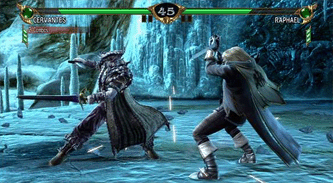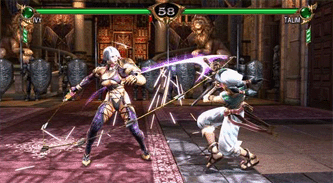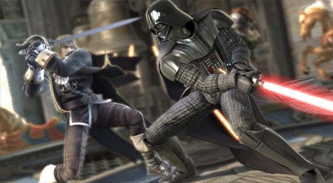So, now that I’ve “taken care of” Zach Rich, I’ll just go ahead and jump right into MY review of Soulcalibur IV. That’s Soulcalibur, not Soul Calibur. For some reason, even though the Soul Calibur games from 1-3 had a space in between Soul and Calibur, Soulcalibur IV does not. I have no idea why. Take it up with your district representative. Now, jumping into the review for real.
There are a number of improvements to the series that come with SCIV, but the biggest improvement has to be the online option. I don’t know about you all, but I don’t have that many friends that fit all the requirements necessary to play this game with me on a regular basis. For one, they’d need to live nearby. Two, they’d need to be fans of videogames, fighting games in particular. Three, they’d need to have near the same level of skill as I do in the game. It’s no fun playing someone who is a ton better than you, or a ton worse than you, and game sessions always end very quickly when players aren’t evenly matched. And four, our schedules would have to match up enough so that we could play decent length sessions. The online feature makes it so you can have a match against a real person pretty much whenever you want. Of course, there is lag sometimes, but it really hasn’t been a problem for me. The bigger problem is that most of the opponents pick the same 2-3 characters and attempt the same 2-3 lame strategies to try to beat you. Oh well, I can’t blame the game for its players being boring!
Another improvement is the Critical Finish system. As you block attacks, this gauge, called the Soul Gauge, turns from blue to red. Eventually, if you keep blocking attacks, your whole life bar blinks red. At this point, your opponent can break your guard. If that happens, a piece of your armor flies off, and your opponent has a chance to perform a Critical Finish. When you execute a Critical Finish, you instantly win the game. This makes players worry a bit more about constantly blocking, and forces games to be a bit more active and interesting, in my opinion. It also reminds me of Soul Blade’s Critical Strikes and weapon breaking system, which is a good thing for me, since I liked both of those things.
Another thing that reminds me of Soul Blade is the ability to change soundtracks in SCIV. In Soul Blade, you had three versions of the soundtrack to choose from. In SCIV, you start with only one soundtrack, but can download others as they become available. As of now, only the original Soul Calibur soundtrack is available, but hopefully they will make the soundtracks of the other games available in the future. It sucks that you have to pay for them all, and you can’t, as of now, use your own music, but it’s still a nice thing to have available. You can also change the music for each stage individually, so you can pick and choose which tracks you want to listen to.
When you start playing the game, you might notice that it is quite a bit different from Soul Calibur III. There is no more tutorial mode, pseudo-strategy adventure mode, tournament mode, mission mode, or choose-your-own-adventure story mode with interactive endings. Instead, there is a shorter, linear story mode with one set ending (a short but gorgeous one) for each character, online mode, and the Tower of Lost Souls. The tower is essentially the mission mode for this game. It is crazily hard at some points, just like the mission modes in every other game in the series, and involves a bunch of different criteria you have to beat the matches under. For example, sometimes enemies have super high defense and you have to use Critical Finish or attack throws or something to beat them, and other times they might be invisible. Pretty much the same stuff you are used to if you have been playing the previous games in the series.
The create-a-character and versus modes (obviously) are still in the game. Some people might not like the fact that there aren’t as many layers to custom characters this time around, but there are tons of pieces, and characters generally look a ton better, so I’m definitely not complaining. There are also 50 slots for custom characters, which is a major step up from the 10 available slots for custom characters in SCIII. The downside to SCIV’s custom characters is that there are no more custom-character specific fighting styles. All custom characters must use a fighting style of one of the 25 regular characters. This does NOT include the guest Star Wars characters, or the boss character, so you can not make yourself into a Jedi. Sorry. (You’ll have to find another way to be a lame-ass.)
In the previous games, you were able to choose different weapons for your characters, custom and otherwise. Sometimes these weapons gave you additional abilities or stat points, and sometimes not. In SCIV, every weapon, and even every piece of armor you put on, affects your stats and abilities. Instead of just giving you abilities, though, the equipment gives you points that allow you to choose your own skills. And really, who wouldn’t want to choose their own skills if given the option? No one; exactly. A big plus is that you can play versus mode in either standard or special. Special allows you to play with all the stats/skills you put on a character, and standard ignores all that and sets you at base-level abilities. This is really helpful when you want to make a custom character who just looks good, and you don’t care to worry about abilities. Otherwise, everyone would have characters who look stupid, not to mention exactly the same as everyone else, just because those lame armor pieces give the best bonuses. Hooray for freedom of choice!
Another difference that may make itself known to you, if you’ve spent any time at all on previous games in the series, is the fact that a lot of the characters have altered movesets. I don’t generally find this to be a problem. I recognize that moves are changed in an attempt to balance the game, and I haven’t had too many instances of wishing a move was still the way it was in an old game. I actually have had a few instances of “ooh, that’s a new move…hey, I love this new move!” and Seong Mi-na is still awesomely fun to play as, even if Kilik steals from her, so I’m perfectly content. The big-shot tournament players will also probably tell you that this game is way more balanced than SCIII, so I guess that’s a plus.
Let’s see, what else…. Oh, yes. This game is still way more fun to play, as far as I’m concerned, than any other fighting game. They didn’t screw with my beloved controls, so it’s still easy enough to pick up and play even if you have no experience with fighters. You won’t be as good as someone who has been playing for years just by picking up the controller, but you’ll at least be able to do moves and have fun, which is all that matters. The one thing I really don’t like is that they didn’t keep in the slippery floor stages, or the ability to have infinite life in versus mode. Some of the most fun matches I’ve had in SCIII were infinite life/slippery floor matches. Oh well.
Even though this installment has less single player content than SCIII, between its story mode, Tower of Lost Souls mode, online versus, and character creation, I’ve already spent over 120 hours playing this with no signs of stopping. Obviously, all of that single player content isn’t necessary to keep a person playing, and, really, isn’t the most important part of fighting games the multiplayer modes, anyway? If you are at all into the Soul series of fighting games, or even fighting games in general, this is definitely a game you need to check out. I’ll even allow you the honor of having a match against me if you get the PS3 version! How can you pass up an offer like that?




Nice post,now I have found a few things and I want to add it to my brains! Thanks you!